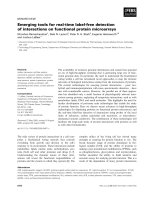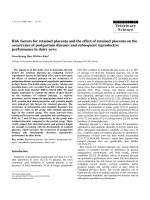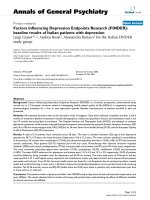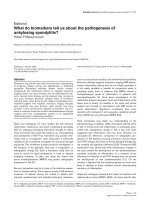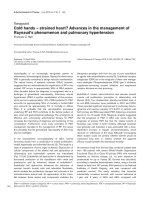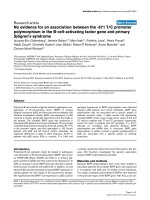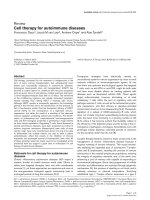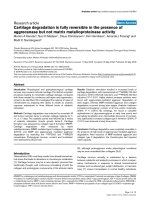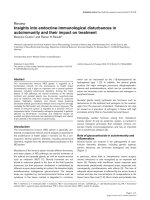Báo cáo y học: "Behavior therapy for pediatric trichotillomania: Exploring the effects of age on treatment outcome" doc
Bạn đang xem bản rút gọn của tài liệu. Xem và tải ngay bản đầy đủ của tài liệu tại đây (444.13 KB, 6 trang )
Franklin et al. Child and Adolescent Psychiatry and Mental Health 2010, 4:18
/>Open Access
RESEARCH
© 2010 Franklin et al; licensee BioMed Central Ltd. This is an Open Access article distributed under the terms of the Creative Commons
Attribution License ( which permits unrestricted use, distribution, and reproduction in
any medium, provided the original work is properly cited.
Research
Behavior therapy for pediatric trichotillomania:
Exploring the effects of age on treatment outcome
Martin E Franklin*
1
, Aubrey L Edson
1
and Jennifer B Freeman
2
Abstract
Background: A randomized controlled trial examining the efficacy of behavior therapy for pediatric trichotillomania
was recently completed with 24 participants ranging in age from 7 - 17. The broad age range raised a question about
whether young children, older children, and adolescents would respond similarly to intervention. In particular, it is
unclear whether the younger children have the cognitive capacity to understand concepts like "urges" and whether
they are able to introspect enough to be able to benefit from awareness training, which is a key aspect of behavior
therapy for trichotillomania.
Methods: Participants were randomly assigned to receive either behavior therapy (N = 12) or minimal attention
control (N = 12), which was included to control for repeated assessments and the passage of time. Primary outcome
measures were the independent evaluator-rated NIMH-Trichotillomania Severity Scale, a semi-structured interview
often used in trichotillomania treatment trials, and a post-treatment clinical global impression improvement rating
(CGI-I).
Results: The correlation between age and change in symptom severity for all patients treated in the trial was small and
not statistically significant. A 2 (group: behavioral therapy, minimal attention control) × 2 (time: week 0, 8) × 2 (children
< 9 yrs., children > 10) ANOVA with independent evaluator-rated symptom severity scores as the continuous
dependent variable also detected no main effects for age or for any interactions involving age. In light of the small
sample size, the mean symptom severity scores at weeks 0 and 8 for younger and older patients randomized to
behavioral therapy were also plotted. Visual inspection of these data indicated that although the groups appeared to
have started at similar levels of severity for children ≤ 9 vs. children ≥ 10; the week 8 data show that the three younger
children did at least as well as if not slightly better than the nine older children and adolescents.
Conclusions: Behavior therapy for pediatric trichotillomania appears to be efficacious even in young children. The
developmental and clinical implications of these findings will be discussed.
Trial Registration: Clinicaltrials.gov NCT00043563.
Background
Trichotillomania (TTM) is a chronic impulse-control dis-
order in which the individual pulls out one's hair to the
point of alopecia. TTM is estimated to affect 1% - 3.5% of
late adolescents and young adults [1]; rates among
younger children are largely unknown [2]. Sufferers of
TTM across the developmental spectrum may experience
medical complications such as skin irritation, infections
and repetitive use hand injuries [3]; those who ingest the
hairs after pulling are at risk for gastrointestinal compli-
cations stemming from trichobezoars (i.e., hairballs);
[4,5]), which have been documented in patients as young
as four [6]. Psychiatric comorbidity is apparently com-
mon, and includes anxiety disorders, mood disorders,
substance use disorders, eating disorders [6,7], and per-
sonality disorders in adults [8] and anxiety and disruptive
behavior disorders in youth [9,2]. Notably, TTM onset in
childhood or adolescence appears to be the norm, and
TTM onset typically precedes that of most comorbidities
[10]. Accordingly, a major priority in TTM psychopathol-
ogy and treatment research is to recruit younger samples
since clinical trials have enrolled children with TTM as
young as seven, so we know that they can participate, if
* Correspondence:
1
Department of Psychiatry, University of Pennsylvania School of Medicine,
Philadelphia, Pennsylvania, USA
Full list of author information is available at the end of the article
Franklin et al. Child and Adolescent Psychiatry and Mental Health 2010, 4:18
/>Page 2 of 6
not do well, with Habit and Reversal Training (HRT) [11].
The goal of improving our understanding of TTM closer
in time to its onset will perhaps, by extension, reduce
future functional impairment and prevent the develop-
ment of debilitating comorbid disorders.
Despite the fact that TTM is a pediatric onset disorder
associated with significant morbidity, comorbidity, and
functional impairment in adults [12], very few TTM psy-
chopathology research studies have actually included
adolescents or children, and there are as yet no published
randomized controlled trials (RCTs) of any psychophar-
macological interventions for youth with TTM. Initial
findings for cognitive-behavioral therapy were encourag-
ing [13], but questions pertaining to the role of develop-
mental factors in TTM psychopathology and treatment
response have yet to be examined. With respect to simi-
larities and differences in TTM presentation across
development, very little is known about symptom presen-
tation in young children, but it appears that the scalp is
the most common pulling site in both adults and older
children and adolescents [7,14,2,15]. Pulling tends to be
both automatic (i.e., outside awareness) and focused (i.e.,
in response to identifiable affective triggers) within each
individual, rather than exclusively one form or the other
[16,17] although it appears that there is a greater prepon-
derance of automatic pulling in younger samples. The
concept of urge plays an important role, as most partici-
pants in TTM studies to date have reported tension or
some other unpleasant sensation that precedes pulling
[12]. Whether urges are present or can be reliably
described by younger patients with TTM is unknown,
although one study among youth and adults with tic dis-
orders [18] found that while adults were able to identify
and verbalize both the premonitory urge to tic and the
relief experienced after indulging that impulse, children
under age 10 were unable to describe the premonitory
urge reliably. Perhaps young children have not yet devel-
oped the expressiveness skills and emotional awareness
[19] required in behavior therapy for TTM, so it is
unclear if young children would actually benefit from
such treatments. Further, as Freeman et al.'s [19] research
demonstrated among young children with OCD, very
young participants may lack the insight, motivation, and
developmental capacity to follow a treatment protocol on
their own, so the protocol may need to be altered to bet-
ter suit these developmental needs and to set the treat-
ment in the context of the family.
Following from Freeman et al.'s [19] work, we wish to
examine whether the developmental issues described
above necessarily preclude the use of child-focused HRT
in the treatment of young children with TTM. For the
reasons outlined above, we believe that HRT designed for
older children and adolescents with TTM will yield the
same gains in treatment outcome when applied to young
children. Further, given that there are no prior published
randomized trials for any treatment for pediatric TTM
and that there is a paucity of information available about
TTM psychopathology and treatment outcome in
younger children with TTM, data in the current report
are being used solely for the purposes of hypothesis gen-
eration.
Methods
Participants
Participants were recruited into a randomized controlled
trial examining the efficacy of behavior therapy for pedi-
atric TTM that was conducted at the University of Penn-
sylvania's School of Medicine. Primary inclusion criteria
for that study were: 1) ages 7 -17 inclusive; 2) diagnosis of
TTM; 3) symptom duration of at least six months; and 4)
participant and at least one parent fluent in English. Pri-
mary exclusion criteria were: 1) a primary psychiatric
diagnosis other than TTM; 2) current bipolar illness,
developmental disorder, or thought disorder; and 3) cur-
rently receiving either pharmacotherapy or concomitant
psychotherapy for TTM. Written informed consent was
obtained from all participants for publication of this
manuscript and accompanying images. A copy of the
written consent is available for review by the Editor-in-
Chief of this journal. Twenty-four patients were random-
ized, 12 to each condition. The sample ranged in age from
7 - 17, with a mean age of 12.5 (2.7); 4 of the 24 partici-
pants (17%) were ≤ 9 years old, with 3 of those partici-
pants randomized to BT. The sample was primarily
Caucasian (75%), primarily female (67%), and had a mean
age of TTM onset of 8.9 years (3.2). Additional informa-
tion about participants randomized to BT can be found
in Table 1. Notably, all 24 patients completed the acute
phase (week 8) of treatment, and all 12 patients random-
ized to BT completed the 8-week maintenance phase.
Table 1: Duration of Pulling, Age of Onset and Number with Comorbidity in Those Assigned to Behavioral Therapy
Average Duration of Pulling
(years)
Average Age of Onset
(years)
Percentage with
Comorbidity
Children ≤ 9 (N = 3) 3.0 (SD = 2.6) 5.3 (SD = 2.1) 33%
Children > 9 (N = 9) 4.0 (SD = 2.3) 8.4 (SD = 3.9) 33%
Franklin et al. Child and Adolescent Psychiatry and Mental Health 2010, 4:18
/>Page 3 of 6
Because all MAC patients were offered open BT at week
8 on ethical grounds, no data on MAC are available
through the maintenance phase of the study. Only data
from the acute phase of the study will be presented in the
current report.
Measures
Diagnostic criteria for TTM were assessed using the Tri-
chotillomania Diagnostic Interview (TDI) [20], which
examined TTM diagnosis according to DSM-IV criteria;
notably, as in other studies of TTM, Criterion B (tension
prior to pulling) and Criterion C (gratification/relief fol-
lowing pulling) were evaluated yet not required for study
entry. Diagnostic criteria for other psychiatric disorders
were surveyed using the Anxiety Disorders Interview
Schedule for Children (ADIS-C) [21], a semi-structured
interview with established psychometric properties. The
TDI and ADIS-C were used to assess diagnostic inclusion
criteria, and were conducted at intake by evaluators
trained to criteria in their use. The primary measure of
treatment outcome was the NIMH Trichotillomania
Severity Scale (NIMH-TSS) [22], which has demon-
strated adequate psychometric properties in prior studies
of TTM treatment [see [23]]. The NIMH-TSS ranges
from 0 (no symptoms) to 25 (severe symptoms), and sur-
veys time spent pulling in the past week, time spent pull-
ing the previous day, resistance to pulling, associated
distress, and functional impairment. Trained indepen-
dent evaluators blind to treatment assignment conducted
the NIMH-TSS interviews at weeks 0, 4, and 8 during the
acute phase of the trial; the same evaluator conducted
assessments throughout the trial to minimize interviewer
effects. A Clinical Global Impression - Improvement
(CGI-I) score was also rated at week 8 by the same blind
evaluator; this scale ranged from 1 (much worse) to 7
(much better), with a score of 4 indicating no change in
symptoms from baseline. Only data from weeks 0 (base-
line) and 8 (post-treatment) assessments are presented in
the current report.
Treatments
Behavior therapy was conducted in accordance with a
manual developed in the context of a treatment develop-
ment grant; this manual has now been published [24].
The acute treatment phase for behavior therapy lasted
eight weeks and was conducted weekly; core elements of
treatment included: 1) psychoeducation about the nature
and treatment of TTM; 2) awareness training, in which
participants were taught to become more aware of pulling
behavior and pulling urges; 3) stimulus control, in which
barriers to pulling were created based on participants'
report of high-risk situations; and 4) competing response
training, in which participants were taught to engage in
behaviors that were physically incompatible with pulling.
Ancillary strategies were also permitted and included:
progressive muscle relaxation (Session 5) and cognitive
restructuring (Session 6); inclusion of these strategies was
discussed in weekly supervision meetings with the Princi-
pal Investigator (MEF). Minimal attention control (MAC)
was employed in this treatment development project to
control for the effects of time and of repeated assessment;
participants who received MAC were introduced to a
therapist at week 0 and met again with the therapist at
weeks 4 and 8. Notably, MAC did not match BT in the
amount of clinical contact, nor was it intended to be an
active intervention. Accordingly, MAC participants were
offered open BT at week 8, thus no comparisons of BT
and MAC were possible beyond week 8. Primary out-
comes for the comparison of BT versus MAC are pre-
sented elsewhere [11] but indicated a clear advantage for
BT over MAC following acute treatment.
Statistical Methods
Study data were examined using three main approaches.
First, the correlation between participants' age and
change in TTM symptoms over the course of treatment
was calculated. Second, combined plots were created to
permit visual inspection of response trends between the
older (≥ 10) and younger (≤ 9) participants; this dichot-
omy was selected based on data from Tourette Syndrome
indicating that children ages 9 and lower have more diffi-
culty reliably reporting on concepts such as urges [see
[18]]. Along with this standard, single-subject approach
to data analysis, an exploratory, mixed repeated-mea-
sures analysis of variance (ANOVA) was conducted to
test for differences between the older and younger groups
in IE-rated TTM severity over time. The NIMH-TSS pre-
treatment distribution of scores appeared to be normal
but, as is often the case in clinical trials in which the
treatments are active, there was some evidence of nega-
tive skew in the distribution at post-treatment; neverthe-
less, ANOVAs were conducted to help better
contextualize study findings against the broader literature
on TTM. Notably, the current study was not powered to
conduct traditional significance testing across multiple
dependent measures, hence the exclusive focus on the
study's primary continuous outcome measure, the blind
IE-rated NIMH TSS scores.
Results and Discussion
Correlation between Age and Change in TTM Symptoms
The correlation between age and change in TTM symp-
toms (NIMH-TSS total score at week 0 - week 8) for all 24
participants in the RCT was 16, which was not signifi-
cant statistically (p = .48) and not supportive of an
expected association between age and change in TTM
symptom severity over time regardless of treatment
received.
Franklin et al. Child and Adolescent Psychiatry and Mental Health 2010, 4:18
/>Page 4 of 6
Group by Time Effects
A 2 (condition: BT, MAC) × 2 (time: week 0, 8) × 2 (age
group: children ≤ 9 yrs., children ≥ 10) ANOVA was con-
ducted, with IE-rated NIMH-TSS scores as the depen-
dent variable. No main effect for age was detected, nor
did any interactions involving age emerge (all Fs < 1.0).
Nevertheless, because children ≤ 9 comprised only 17% of
the sample, statistical power to detect differences is
inherently limited. Although statistical comparisons were
not conducted, data on percentages of those with
improved or very much improved CGI-I scores are pre-
sented in Table 2.
Visual Inspection of Plotted NIMH-TSS Data
In order to further explore the possible influence of
developmental factors on behavior therapy outcomes
specifically, all NIMH-TSS scores at weeks 0 and 8 for
younger and older patients randomized to BT were plot-
ted and visually inspected as evident in Additional File 1
(Figure 1), and the mean NIMH-TSS scores at pre and
post-treatment for both age groups are presented in
Additional File 2 (Figure 2). Although, NIMH-TSS scores
at week 0 appear to be quite similar ((M = 12.7 (4.0) for
children ≤ 9 vs. M = 11.2 (2.3) for children ≥ 10)) and the
within-subjects effect sizes for both groups were very
large (see Table 2), the week 8 data suggests that the three
younger children ((M = 0.7 (1.9)) did at least as well as if
not slightly better than the nine older children and ado-
lescents ((M = 4.4, (1.4)), although developmental issues
such as ability to understand evaluators' questions about
urges and recall pulling behavior over the course of the
past week may decrease confidence in the outcomes for
the young children.
Conclusions
The purpose of the current report was to explore whether
developmental factors influenced change in TTM symp-
toms in a pediatric sample randomly assigned to receive
either behavior therapy or a comparison condition
designed to control for the effects of time and repeated
assessments. Findings indicated that there was a small,
negative, and insignificant relationship between partici-
pants' age and change in TTM symptoms over the course
of the acute phase of the trial. When a mixed ANOVA
was employed to further explore the effects of age on
treatment outcome, here again no effects for develop-
mental level emerged. Low power could have obscured
such effects, however, so inspection of behavior therapy
outcomes specifically was warranted in order to generate
hypotheses about whether the youngest participants
might have experienced attenuated outcomes relative to
their older counterparts. The behavior therapy protocol
for TTM includes techniques that require at least some
ability to introspect (e.g., awareness training), and the tai-
loring of subsequent treatment strategies such as stimu-
lus control and competing response training rest upon
increased awareness of the presence of urges to pull. Our
data here were somewhat surprising given initial con-
cerns about the ability of young children to grasp these
core concepts in that their outcomes were clearly not
attenuated, and were even suggestive of the possibility
that children age 7 - 9 might experience more success in
BT than their older counterparts.
Data emerging from cross-sectional comparisons of
TTM in different developmental stages might help
explain this seemingly anomalous observation, in that it
appears that pulling in younger children might be more
"automatic" and less affect-driven than it appears to be in
older children and in adults [16]. Younger children also
report fewer pulling sites than do older children and
adults [25], again suggesting that TTM might become
more complex over time. Driven by accumulating evi-
Table 2: Pre and Post Treatment NIMH-TSS Scores, NIMH-TSS Effect Sizes and Percentage Improved or Very Improved on
the CGI-I
Pre-Treatment NIMH-
TSS Scores (M)
Post-Treatment NIMH-
TSS Scores (M)
NIMH-TSS Within-
Subjects Effects Size
(Cohen's d)
Percentage
Improved or Very
Much Improved on
the CGI
Children ≤ 9 (N = 3) 11.2 (SD = 2.3) 0.7 (SD = 1.9) 2.68 100%
Children >9 (N = 9) 12.7 (SD = 3.0) 4.4 (SD = 1.4) 1.19 67%
Figure 1 Change in NIMH-TSS Scores. This figure represents the
change in NIMH-TSS scores from week 0 to week 8 for each of those
participants randomized to BT
Change in NIMH-TSS Scores
0
5
10
15
20
25
Week 0 Week 8
NIMH-TSS Scores
Children
Age 10
and
Older
Children
Age 9
and
Younger
Franklin et al. Child and Adolescent Psychiatry and Mental Health 2010, 4:18
/>Page 5 of 6
dence that relapse is common following BT in adults [26],
current treatment development research in adult TTM
has focused recently on incorporating treatment compo-
nents to address emotions specifically [27]. What cannot
be examined using data from the current study, however,
is whether developmental factors such as inability to
introspect or report on concepts such as urges would
negatively impact treatment of children younger than age
7. There is now evidence in pediatric OCD indicating that
a family-based intervention involving exposure plus
response prevention for children ages 4 -8 was superior
to a relaxation control condition [19]; it may well be the
case that similar treatment development efforts in pediat-
ric TTM will permit effective intervention that can be
delivered to children even younger than those who par-
ticipated in the current study. Our findings of comparable
if not slightly better treatment outcomes for younger chil-
dren are not entirely consistent across pediatric onset dis-
orders in which urges play a prominent role such as in
Tourette Syndrome; thus, cross-diagnostic studies are
clearly needed to examine urge phenomenology and
response to behavioral treatments such as HRT in which
urge awareness may play a prominent role in signaling the
patient to engage in a competing behavior. Such efforts
are indeed underway, and will closely mirror efforts
already being made in OCD specifically to properly con-
textualize the behavioral intervention in view of develop-
mental considerations, given the misinformation about
these conditions that many families have been exposed to
prior to seeking treatment, and the deleterious interactive
effects of these conditions on family environment and on
specific family members.
All of the limitations inherent in any study with a sam-
ple size this small are applicable here as well, and thus
even our preliminary conclusions must be interpreted
with considerable caution. Nevertheless, the dearth of
published research in pediatric TTM necessitates efforts
at empirical hypothesis generation wherever possible,
which is what led to the exploration reported above. A
second randomized controlled trial funded by the
National Institute of Mental Health in the U.S. that com-
pares the efficacy of BT to a more active control condi-
tion that equates therapist contact time
(Psychoeducation/Supportive Counseling) is underway at
Penn but, unfortunately, reviewer concerns about the
developmental issues discussed above necessitated a
design decision to truncate the age range to 10 - 17. There
are very few other sources of knowledge available about
treatment efficacy for children with TTM who are
younger than age 10, and thus we felt that, despite the
obvious caveats, it was important to take the opportunity
provided by these data to help stimulate thinking about
whether and how best to intervene in young children
with TTM.
Competing interests
The authors declare that they have no competing interests.
Authors' contributions
ALE wrote the Backgrounds section and was responsible for formatting
responsibilities. MEF was the study investigator and authored the majority of
the manuscript. MEF and JBF conducted analyses, interpreted the data and
revised the manuscript. ALE, MEF and JBF reviewed and approved the final ver-
sion of the manuscript.
Acknowledgements
The authors would like to note their appreciation for the National Institute of
Mental Health (NIMH), which was responsible for the funding of this study's
data collection and data analysis phase. The authors would also like to thank
the Deutsche Forschungsgemeinschaft (DFG), which funded the article pro-
cessing charge (APC) for publication of this article.
Author Details
1
Department of Psychiatry, University of Pennsylvania School of Medicine,
Philadelphia, Pennsylvania, USA and
2
Department of Psychiatry, Alpert Medical
School of Brown University, Providence, Rhode Island, USA
References
1. Christenson GA, Pyle RL, Mitchell JE: Estimated lifetime prevalence of
trichotillomania in college students. Journal of Clinical Psychiatry 1991,
52:415-417.
2. Tolin DF, Franklin ME, Diefenbach GJ, Anderson E, Meunier SA: Pediatric
trichotillomania: Descriptive psychopathology and an open trial of
cognitive-behavioral therapy. Cognitive Behaviour Therapy 2007,
36:129-144.
3. du Toit PL, van Kradenburg J, Niehaus DHJ, Stein DJ: Characteristics and
phenomenology of hair-pulling: An exploration of subtypes.
Comprehensive Psychiatry 2001, 42:247-256.
4. Bouwer C, Stein DJ: Trichobezoars in trichotillomania: Case report and
literature overview. Psychosomatic Medicine 1998, 60:658-660.
5. Swedo SE, Leonard HL: Trichotillomania: An obsessive compulsive
spectrum disorder? Psychiatric Clinics of North America 1992, 15:777-790.
Received: 4 January 2010 Accepted: 28 June 2010
Published: 28 June 2010
This article is available from: 2010 Franklin et al; licensee BioMed Central Ltd. This is an Open Access article distributed under the terms of the Creative Commons Attribution License ( which permits unrestricted use, distribution, and reproduction in any medium, provided the original work is properly cited.Child and Ado lescent Psychiatr y and Mental Heal th 2010, 4:18
Figure 2 Change in Mean NIMH-TSS Scores. This figure represents
the mean change in NIMH-TSS scores from week 0 to week 8 for those
participants randomized to BT; the figure represents the difference be-
tween mean changes among the participants who were age 9 or
younger and participants were age 10 or older.
Change in Mean NIMH-TSS Scores
0
2
4
6
8
10
12
14
Week 0 Week 8
NIMH-TSS Score
Children <
Age 9
Children >
Age 10
Franklin et al. Child and Adolescent Psychiatry and Mental Health 2010, 4:18
/>Page 6 of 6
6. Lanoue JL, Arkovitz MS: Trichobezoar in a four-year-old-girl. New
England Journal of Medicine 2003, 348(13):1242.
7. Christenson GA, Mackenzie TB, Mitchell JE: Characteristics of 60 adult
chronic hair pullers. American Journal of Psychiatry 1991, 148:365-370.
8. Christenson GA, Chernoff-Clementz E, Clementz BA: Personality and
clinical characteristics in patients with trichotillomania. Journal of
Clinical Psychiatry 1992, 53:407-413.
9. King RA, Scahill L, Vitulano LA, Schwab-Stone M: Childhood
trichotillomania: Clinical phenomenology, comorbidity, and family
genetics. Journal of the American Academy of Child & Adolescent Psychiatry
1995, 34:1451-1459.
10. Christenson GA, Mackenzie TB: Trichotillomania, body dysmorphic
disorder, and obsessive-compulsive disorder. Journal of Clinical
Psychiatry 1995, 56:211-212.
11. Franklin MF, Cahill SP, Roth Ledley D, Cardona D, Anderson E: BT for
Pediatric Trichotillomania: A Randomized Controlled Trial. World
Congress of Behavioral and Cognitive Therapies, Barcelona, Spain 2007.
12. Woods DW, Flessner CA, Franklin ME, Keuthen NJ, Goodwin R, Stein DJ,
Walther M, Trichotillomania Scientific Advisory Board: The
Trichotillomania Impact Project (TIP): Exploring phenomenology,
functional impairment, and treatment utilization. Journal of Clinical
Psychiatry 2006, 67:1877-1888.
13. Franklin ME, Cahill SP, Roth Ledley DA, Cardona D, Anderson E: Behavior
therapy for pediatric trichotillomania: A randomized controlled trial. In
Proceedings of the American Academy of Child and Adolescent Psychiatry
Boston, MA; 2007.
14. Reeve E: Hair pulling in children and adolescents. In Trichotillomania
Edited by: Stein DJ, Christenson GA, Hollander E. Washington, D.C:
American Psychiatric Association Press; 1999:201-224.
15. Wright HH, Holmes GR: Trichotillomania (hair pulling) in toddlers.
Psychological Reports 2003, 92:228-230.
16. Flessner CA, Conelea CA, Woods DW, Franklin ME, Keuthen NJ: Styles of
pulling in trichotillomania: exploring differences in symptom severity,
phenomenology, and functional impact. Behaviour Research and
Therapy 2008, 46:345-357.
17. Flessner CA, Woods DW, Franklin ME, Keuthen NJ, Piacentini J: Styles of
pulling in youth with trichotillomania: Exploring differences in
symptom severity, phenomenology, and comorbid psychiatric
symptoms. Behaviour Research and Therapy 2008, 46:1055-1061.
18. Woods DW, Piacentini JC, Himle MB, Chang S: Initial development and
psychometric properties of the premonitory urge for tics scale (PUTS)
in children with Tourette syndrome. Journal of Developmental and
Behavioral Pediatrics 2005, 26:397-403.
19. Freeman JB, Garcia AM, Coyne L, Ale C, Przeworski A, Himle M, Compton S,
Leonard H: Early childhood OCD: Preliminary findings from a family-
based cognitive-behavioral approach. Journal of the American Academy
of Child and Adolescent Psychiatry 2008, 47:593-602.
20. Rothbaum BO, Ninan PT: The assessment of trichotillomania. Behaviour
Research and Therapy 1994, 32:651-662.
21. Silverman WK, Albano AM: Anxiety Disorders Interview Schedule for
DSM-IV: Child Version. San Antonio Texas: The Psychological
Corporation; 1996.
22. Swedo SE, Leonard HL, Rapoport JL, Lenane M, Goldberger EL, Cheslow D:
A double-blind comparison of clomipramine and desipramine in the
treatment of trichotillomania (hair pulling). New England Journal of
Medicine 1998, 321:497-501.
23. Diefenbach GJ, Tolin DF, Crocetto J, Maltby N, Hannan S: Assessment of
trichotillomania: A psychometric evaluation of hair-pulling scales.
Journal of Psychopathology & Behavioral Assessment 2005, 27:169-178.
24. Franklin ME, Tolin DF: Treating trichotillomania: Cognitive-behavioral
therapy for hairpulling and related problems. New York, New York:
Springer Science + Business Media; 2007.
25. Franklin ME, Flessner CA, Woods DW, Keuthen NJ, Piacentini JC, Moore P,
Stein DJ, Cohen SB, Wilson MA: The child and adolescent
trichotillomania impact project: Descriptive psychopathology,
comorbidity, functional impairment, and treatment utilization. Journal
of Developmental and Behavioral Pediatrics 2008, 29(6):493-500.
26. Woods DW, Flessner CA, Franklin ME, Wetterneck CT, Walther M, Anderson
E, Cardona D: Understanding and treating trichotillomania: What we
know and what we don't know. Psychiatric Clinics of North America 2006,
29:487-501.
27. Woods DW, Wetterneck CT, Flessner CA: A controlled evaluation of
acceptance and commitment therapy plus habit reversal for
trichotillomania. Behaviour Research and Therapy 2006, 44(5):639-656.
doi: 10.1186/1753-2000-4-18
Cite this article as: Franklin et al., Behavior therapy for pediatric trichotillo-
mania: Exploring the effects of age on treatment outcome Child and Adoles-
cent Psychiatry and Mental Health 2010, 4:18
